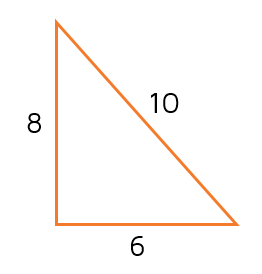Parts of a Right Triangle (Based on Sides)
- The legs of a right triangle are ALWAYS perpendicular (meet at 90° right angles).
- The hypotenuse is always across from (diagonal) from the 90° right angle.
- The hypotenuse is ALWAYS the longest side of a right triangle.

Pythagorean Theorem
Pythagorean Theorem – the sum of the squares of the two legs of a right triangle is equal to the square of the hypotenuse.
- Hypotenuse is ALWAYS “c“
- Legs are ALWAYS “a” and “b“
- “a” and “b” are the shortest sides.
- “a” and “b” are always perpendicular.
- “a” and “b” are interchangeable, because “a2 + b2” is the same as (equal to) “b2 + a2” (commutative property of addition).


Converse of the Pythagorean Theorem
Converse of the Pythagorean Theorem – If the sum of the squares of the two sides of a triangle is equal to the square of the longest side, then the triangle is a right triangle.
- See Example (Below) & Ask Yourself:
- Is this a right triangle?”
- Use the Converse Pythagorean Theorem to find out!
- Use the Converse Pythagorean Theorem to find out!
- What is the sum of the squares of the two smaller sides (the legs)?
- 62 + 82 Square each Leg
- 36 + 64 Add the Squares
- 100 Simplify
- Does the square of the largest side (the hypotenuse) also equal 100?
- Yes, 102 = 100; so, this IS a right triangle!
- Is this a right triangle?”

